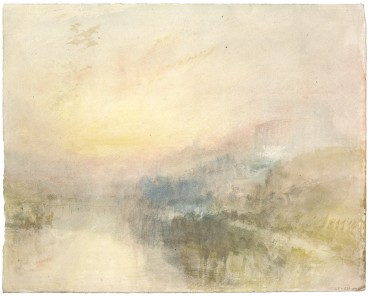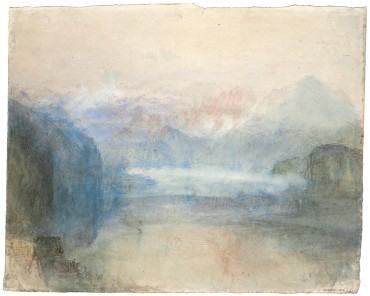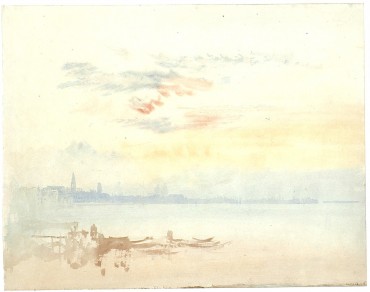
J. M. W. Turner, Walhalla near Regensburg at the Danube, 1840

J. M. W. Turner, Lake of Lucerne from Brunnen, 1842

J. M. W. Turner, Venice as from the Giudecca - sunrise, 1819
16.7.2014 – Issue 14 - Air – Sauter Florian – Essays
J. M. W. Turner: Lost Paradise
by Florian Sauter
What makes us human is the liberty to invent things that do not exist in nature. Undermining that fact, J. M. W. Turner in his paintings deliberately depicted not the direct impressions he observed, but filled the canvas with his imaginative power. Vaguely defining the main outlines of a scenery on site at first, the rest of the canvas – its colorful infill – was only added later to become his own and ideal creation that rivaled the actual one in complete detail and precision. For that, Turner studied the hydrodynamic behavior of wave-formations, mastered the essentials of dynamic cloud motion, appropriated the principles of geological structures and the growth patterns of biological forms – in short those essentials of nature’s underlying order that allowed him ultimately to transcend the mere representation of the world in order to actually create his own.
The nature with which he filled his canvases was an exalted one – a most dramatic vision of the world in its original state when the elements in pure form and energy contracted, repelled and merged with one another to shape a forever lost paradise. For that reason, he was most entranced by violent rain and snow, raw mountain cliffs and avalanches, heavy lighting bolts and thunder storms over the oceans, but also calm moon light, fog or twilight – at all, nature in its most extreme and awesome, or in the Romantic jargon of the time, ‘sublime’ and ‘grand’ condition. Regarding the artificial only as a minor outgrowth of that larger natural order, the human figure and the manmade constructions vanished within these seething amalgams of the primal condition into minor, insignificant specks of matter. This way, the contrast was even more heightened between an indifferent, raw universe, and the anti-heroic smallness of man, who could only in his poetic visions match the majesty of the former.
Attracted by explosive force, Turner fused the natural elements in a mist-like, melliflous way: water merged with air, the sun fired up the earth – never fixed, they were his universal elixirs that in a frenzy state of becoming etherally coalesced. Much of this fluency derived from his peculiar aquarelle technique, in which he plunged the paper with the initial sketch into a pail of water and then on the wet surface let the principal colors be washed into each other. In tonal equilibrium and radiant luminance, he later managed to translate the essentially transparent and atmospheric qualities of watercolor to other, more opaque mediums like oil paint. Despite all elementary fusion, Turner, working from light to dark, was still able to project spatial depth and concrete points of reference into these apocalyptic scenes trenched in warmly diffused Mediterranean light. Flooding his paintings with increasingly abstract color fields towards the end of his life, apparently only the sun’s hazy-golden brilliance brought turbulence and motion into the broadly intermingling stretches of sky, sea and ground – it activated these with its intensity like an entheal force, whose ecstatic energies penetrated and excited all tangible forms of the world‘s eternal becoming.
Download article as PDF

